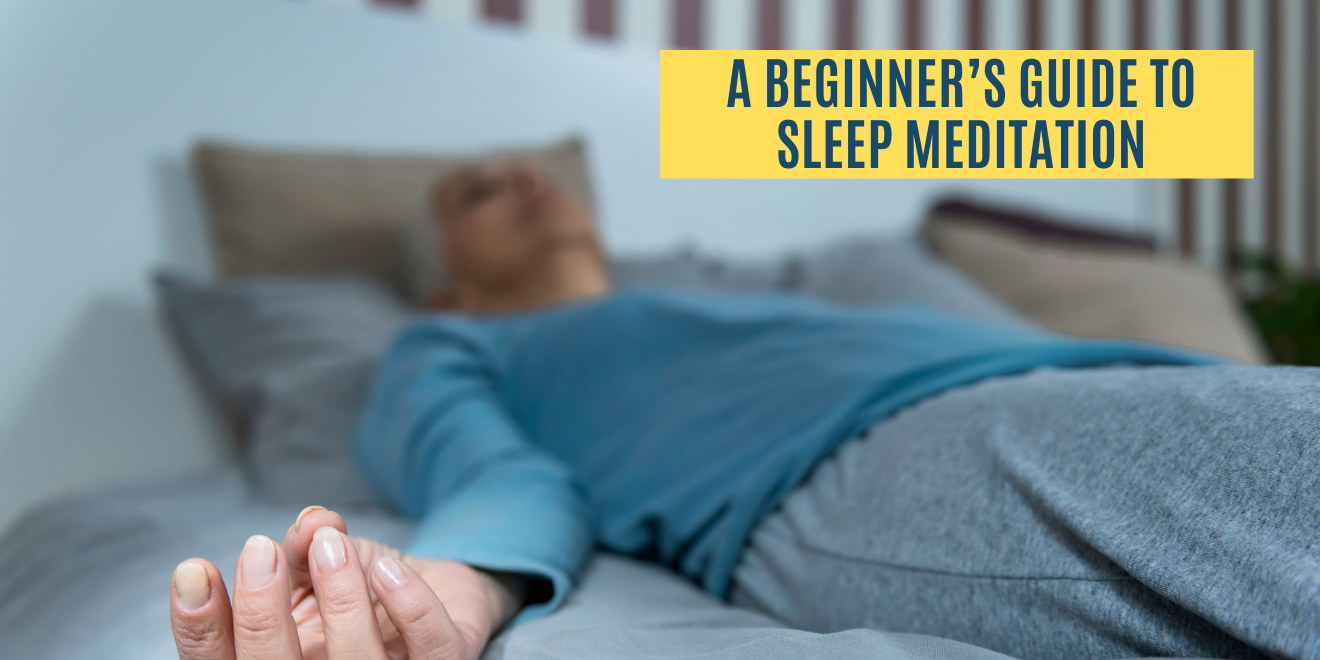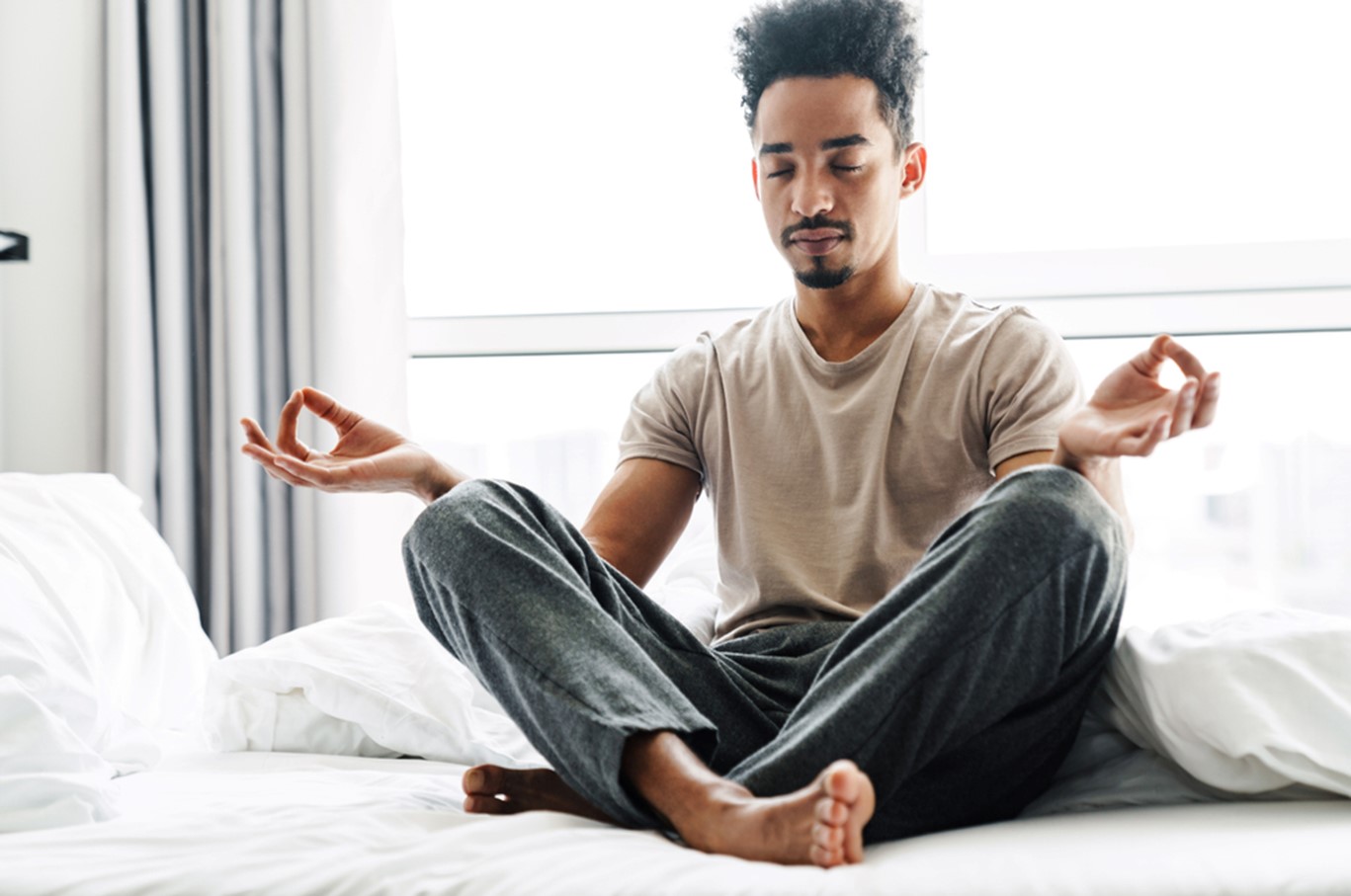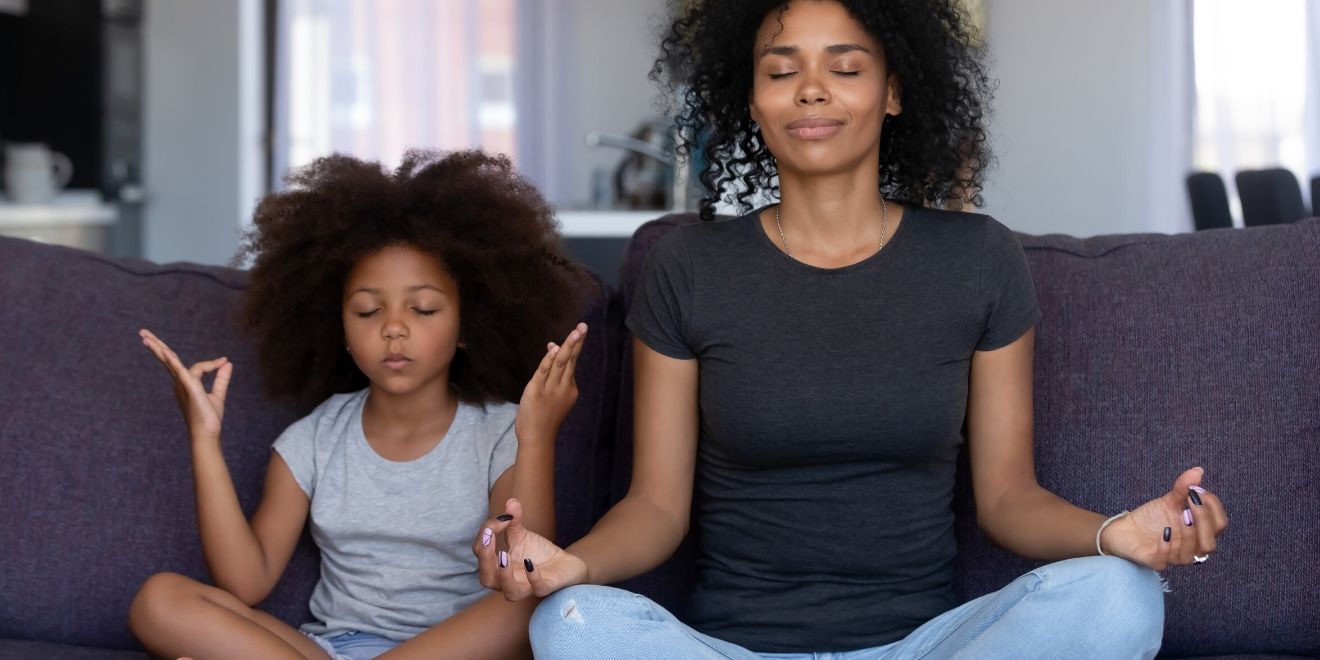A Beginner’s Guide to Sleep Meditation

Wouldn’t it be nice if our brains had an “off switch” for sleep? Sleep can be elusive for any number of reasons, but one of the more common culprits is a racing mind.
Maybe you’re stressing over a financial issue or thinking about everything you need to get done the next day. These thoughts have a tendency to escalate in the evening, resulting in increased anxiety or feelings of unease.
Perhaps you’ve tried a handful of products to help you sleep, such as calming teas, melatonin, and weighted blankets for anxiety. But if your mind is still going a mile a minute before bed, there's one more tool you need to add to your bedtime arsenal: sleep meditation.

During the day, our minds are constantly jumping from one task to another. But when it’s time for bed, there’s nothing left for us to do, so our brains try to prepare us for tomorrow’s to-do list. This can lead to racing thoughts that increase our heart rate, making it difficult to fall asleep.
Enter sleep meditation. Sleep meditation encompasses a variety of techniques that train the mind to focus on the present, allowing us to let go of worrying thoughts that keep us up at night. With regular practice, meditation for sleep can help put your mind and body into a state of relaxation — thus making it easier to fall into a truly restful sleep.
Yogi masters and Buddhists have long touted the many benefits of meditation, but can this age-old practice actually help you sleep? According to science, the answer is a resounding yes.
According to experts, meditation helps us fall asleep in several ways.
First, it slows our breath and heart rate, putting us in a more relaxed state. Meditation also decreases the intensity of brain waves, which allows us to fall into a deeper slumber.
Science appears to back this up. According to research published by the American Academy of Sleep Medicine, meditation was shown to be an effective treatment for patients with insomnia.
In a different study, researchers studied the effects of mindful meditation in older adults with moderate sleep disturbances. They concluded that meditation may be a useful treatment for sleep problems in older adults.

Meditation is a simple practice that you can do anywhere, anytime. But be warned: You may not feel the benefits right away. Stick with it, though, and you’ll be well on your way to a good night’s rest.
To help you get started, here are a few simple tips and tricks for sleep meditation.
Before you meditate, make sure that your bedroom is calm and quiet. It’s difficult to focus on your breathing when you’re constantly distracted by scratchy sheets, bright lights, and the sound of the television.
Set yourself up for meditation success by turning your bedroom into a tranquil oasis. If your sheets are scratchy and uncomfortable, swap them for luxury bedding that feels soft against your skin. Minimize noise disturbances by closing your bedroom door and listening to meditation music.
Don’t forget to tidy up your room! A clutter-free room helps promote a clutter-free mind.
Next, change into a cozy pair of pajamas (or whatever you find most comfortable) and get into bed. Most people prefer to lie down while sleep meditating for obvious reasons, but you can also sit upright if it feels more comfortable.
Start your meditation session by closing your eyes and taking long, slow, deep breaths. Breathing is a key component in meditation because it sends a message to your brain that it’s time to relax.
Inhale and exhale slowly, focusing on your breaths as you do so. If your mind wanders, that’s OK. Gently bring your mind back to your breathing.

Tip: Take a moment to learn about diaphragmatic breathing — aka, belly breathing. Not only is belly breathing useful for meditation practice, it’s also a great way to calm your body down during a panic or anxiety attack.
Ever notice how stress can manifest as physical symptoms such as tense muscles, headaches, and chest pain?
Sometimes, we’re so stressed that we don’t even realize that our aches and pains are anxiety-related. That’s where body scan meditation comes in handy. This simple technique involves mentally scanning your body to help bring awareness to specific body parts, as well as interesting sensations or sources of tension or discomfort.
To perform a meditation body scan , lie down in your bed and take deep breaths. Start with your feet and work your way up, noticing the different sensations of each body part and acknowledging any pain or tension as you go.
Similar to a meditation body scan, progressive muscle relaxation is also a meditation technique that helps bring awareness to your body. This technique involves tensing one muscle group for a few seconds before releasing the tension and moving onto the next muscle group.
To practice this technique, tense a muscle group (like your buttocks) as you inhale and hold it for five seconds. On the exhale, release the tension. Give yourself 10 to 15 seconds to relax before moving on to the next muscle group.
If you’re looking for an easy way to get into sleep meditation, guided meditation is it. Sometimes called visualization or guided imagery, this meditation method focuses on creating relaxing images in your brain that help you reduce stress. For example, if you love the ocean, you could picture yourself on the beach. Focus on your senses: what the sand feels like in-between your toes; the sound of crashing waves; the gentle warmth of the sun on your back.

These are just a handful of meditation techniques that can help you achieve a better night’s rest. Play around with them until you find a meditation method that works for you. And remember: It’s normal to feel like you’re doing it wrong in the beginning. Stick with it and better sleep will soon be yours.
Maybe you’re stressing over a financial issue or thinking about everything you need to get done the next day. These thoughts have a tendency to escalate in the evening, resulting in increased anxiety or feelings of unease.
Perhaps you’ve tried a handful of products to help you sleep, such as calming teas, melatonin, and weighted blankets for anxiety. But if your mind is still going a mile a minute before bed, there's one more tool you need to add to your bedtime arsenal: sleep meditation.

What Is Sleep Meditation?
During the day, our minds are constantly jumping from one task to another. But when it’s time for bed, there’s nothing left for us to do, so our brains try to prepare us for tomorrow’s to-do list. This can lead to racing thoughts that increase our heart rate, making it difficult to fall asleep.
Enter sleep meditation. Sleep meditation encompasses a variety of techniques that train the mind to focus on the present, allowing us to let go of worrying thoughts that keep us up at night. With regular practice, meditation for sleep can help put your mind and body into a state of relaxation — thus making it easier to fall into a truly restful sleep.
Does Sleep Meditation Work?
Yogi masters and Buddhists have long touted the many benefits of meditation, but can this age-old practice actually help you sleep? According to science, the answer is a resounding yes.
According to experts, meditation helps us fall asleep in several ways.
First, it slows our breath and heart rate, putting us in a more relaxed state. Meditation also decreases the intensity of brain waves, which allows us to fall into a deeper slumber.
Science appears to back this up. According to research published by the American Academy of Sleep Medicine, meditation was shown to be an effective treatment for patients with insomnia.
In a different study, researchers studied the effects of mindful meditation in older adults with moderate sleep disturbances. They concluded that meditation may be a useful treatment for sleep problems in older adults.

- How to Meditate Before Bed
Meditation is a simple practice that you can do anywhere, anytime. But be warned: You may not feel the benefits right away. Stick with it, though, and you’ll be well on your way to a good night’s rest.
To help you get started, here are a few simple tips and tricks for sleep meditation.
1. Rid Your Bedroom of Distractions
Before you meditate, make sure that your bedroom is calm and quiet. It’s difficult to focus on your breathing when you’re constantly distracted by scratchy sheets, bright lights, and the sound of the television.
Set yourself up for meditation success by turning your bedroom into a tranquil oasis. If your sheets are scratchy and uncomfortable, swap them for luxury bedding that feels soft against your skin. Minimize noise disturbances by closing your bedroom door and listening to meditation music.
Don’t forget to tidy up your room! A clutter-free room helps promote a clutter-free mind.
2. Get Comfortable
Next, change into a cozy pair of pajamas (or whatever you find most comfortable) and get into bed. Most people prefer to lie down while sleep meditating for obvious reasons, but you can also sit upright if it feels more comfortable.
3. Engage in Deep Breathing
Start your meditation session by closing your eyes and taking long, slow, deep breaths. Breathing is a key component in meditation because it sends a message to your brain that it’s time to relax.
Inhale and exhale slowly, focusing on your breaths as you do so. If your mind wanders, that’s OK. Gently bring your mind back to your breathing.

Tip: Take a moment to learn about diaphragmatic breathing — aka, belly breathing. Not only is belly breathing useful for meditation practice, it’s also a great way to calm your body down during a panic or anxiety attack.
4. Do a Meditation Body Scan
Ever notice how stress can manifest as physical symptoms such as tense muscles, headaches, and chest pain?
Sometimes, we’re so stressed that we don’t even realize that our aches and pains are anxiety-related. That’s where body scan meditation comes in handy. This simple technique involves mentally scanning your body to help bring awareness to specific body parts, as well as interesting sensations or sources of tension or discomfort.
To perform a meditation body scan , lie down in your bed and take deep breaths. Start with your feet and work your way up, noticing the different sensations of each body part and acknowledging any pain or tension as you go.
5. Practice Progressive Muscle Relaxation
Similar to a meditation body scan, progressive muscle relaxation is also a meditation technique that helps bring awareness to your body. This technique involves tensing one muscle group for a few seconds before releasing the tension and moving onto the next muscle group.
To practice this technique, tense a muscle group (like your buttocks) as you inhale and hold it for five seconds. On the exhale, release the tension. Give yourself 10 to 15 seconds to relax before moving on to the next muscle group.
6. Try a Guided Meditation
If you’re looking for an easy way to get into sleep meditation, guided meditation is it. Sometimes called visualization or guided imagery, this meditation method focuses on creating relaxing images in your brain that help you reduce stress. For example, if you love the ocean, you could picture yourself on the beach. Focus on your senses: what the sand feels like in-between your toes; the sound of crashing waves; the gentle warmth of the sun on your back.

These are just a handful of meditation techniques that can help you achieve a better night’s rest. Play around with them until you find a meditation method that works for you. And remember: It’s normal to feel like you’re doing it wrong in the beginning. Stick with it and better sleep will soon be yours.
Additional resources:
- Empower your meditation with the right blinds and curtains
- Mental health tips for super dads
- Scientifically proven benefits of mindfulness and meditation




































































































